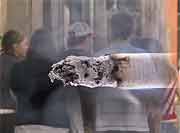
TUESDAY, Nov. 20 (HealthDay News) — Levels of secondhand smoke outside smoking rooms and other designated smoking areas in airports are five times higher than in smoke-free airports, a new U.S. study finds.
These high levels of secondhand smoke put the health of travelers and airport employees at risk, according to the U.S. Centers for Disease Control and Prevention researchers who published their findings Nov. 20 in the CDC’s Morbidity and Mortality Weekly Report.
Their study of five large hub U.S. airports also found that air pollution levels inside designated smoking areas — such as ventilated smoking rooms, restaurants and bars — were 23 times higher than air pollution levels in airports that were completely smoke-free.
The findings “further confirm that ventilated smoking rooms and designated smoking areas are not effective,” Dr. Tim McAfee, director of CDC’s Office on Smoking and Health, said in an agency news release. “Prohibiting smoking in all indoor areas is the only effective way to fully eliminate exposure to secondhand smoke.”
Five of the 29 largest U.S. airports allow smoking in designated areas that are accessible to the public. The airports are: Hartsfield-Jackson Atlanta International Airport, Washington Dulles International Airport, McCarran International Airport in Las Vegas, Denver International Airport and Salt Lake City International Airport.
In 2011, about 15 percent of all U.S. air travel took place at these five airports, accounting for more than 110 million passenger boardings, the CDC authors noted.
Smoking is banned on all U.S. domestic and international commercial airline flights, but no federal law requires airports to be smoke-free.
“Instead of going entirely smoke-free, five airports continue to allow smoking in restaurants, bars or ventilated smoking rooms. However, research shows that separating smokers from nonsmokers, cleaning the air and ventilating buildings cannot fully eliminate secondhand smoke exposure,” report co-author Brian King, an epidemiologist with CDC’s Office on Smoking and Health, said in the news release.
“People who spend time in, pass by, clean or work near these rooms are at risk of exposure to secondhand smoke,” King added.
There is no risk-free level of exposure to secondhand smoke, according to a 2006 U.S. Surgeon General’s report. The effects of secondhand smoke include heart disease and lung cancer in nonsmoking adults, and sudden infant death syndrome (SIDS), respiratory problems, ear infections and asthma attacks in infants and children.
More information
The American Lung Association has more about secondhand smoke.

